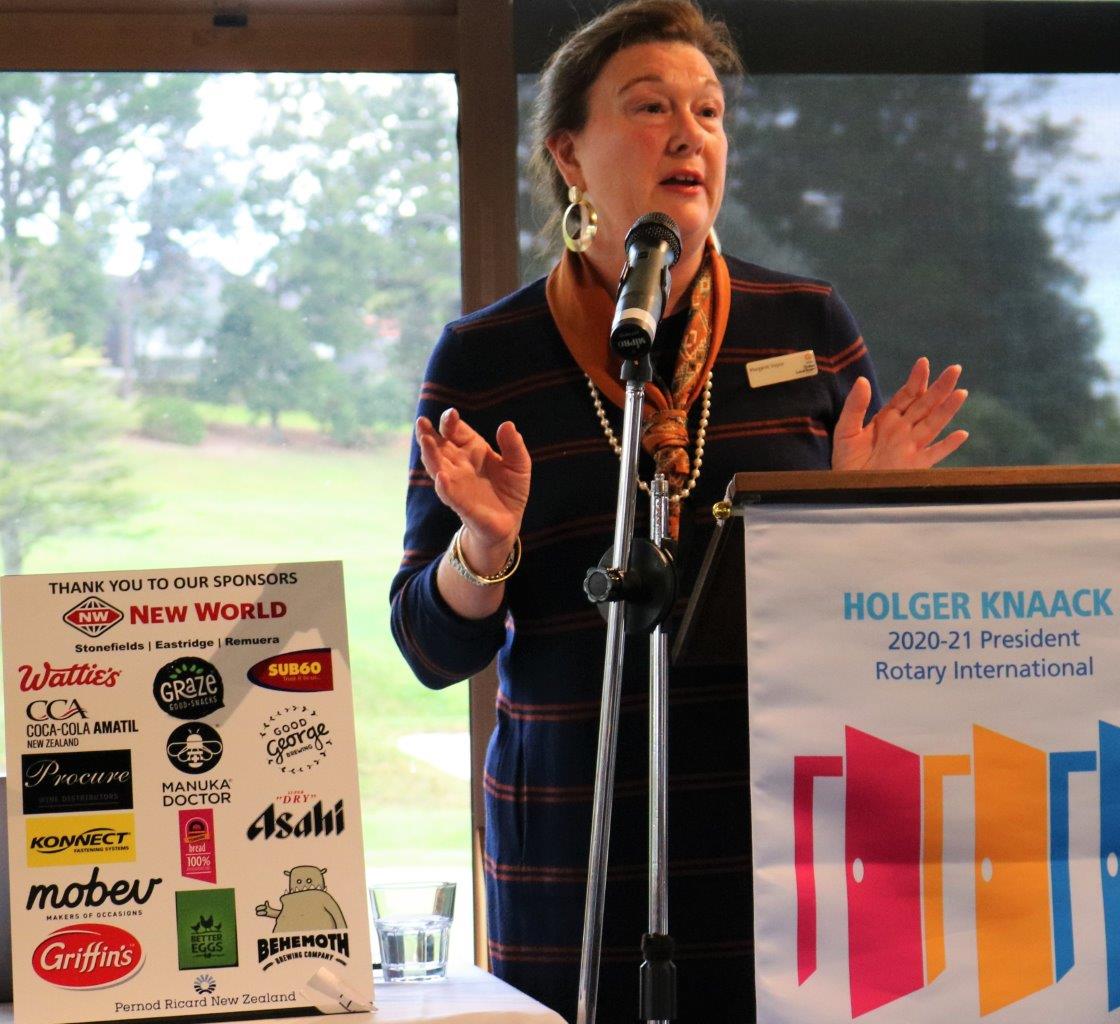Possibly due to the long weekend and school holidays, numbers were down this week, with only 22 members in attendance, plus our guest speaker.
However, those in attendance were in fine form! Sergeant of the Day (Aubrey) led a resolutely researched and lively Sergeant’s session which was very enthusiastically countered with the usual St John’s humour and back chat.
 Our guest speaker was Margaret Voyce, who is a member of the Orakei Local Board and is their Environmental spokesperson. Her portfolio also includes Watercare and Civil Defence. Margaret opened by advising that she ‘loves Rotary’ and explained that when she was slightly younger, she was a Rotaract member and a RYLA recipient. She also informed us that Peter Buchanan was a ‘legend in his own lunchtime’ having heard Ruud Kleinpaste talk about Peter on his radio show!
Our guest speaker was Margaret Voyce, who is a member of the Orakei Local Board and is their Environmental spokesperson. Her portfolio also includes Watercare and Civil Defence. Margaret opened by advising that she ‘loves Rotary’ and explained that when she was slightly younger, she was a Rotaract member and a RYLA recipient. She also informed us that Peter Buchanan was a ‘legend in his own lunchtime’ having heard Ruud Kleinpaste talk about Peter on his radio show!As Environmental spokesperson, Margaret discovered there were a lot of different environmental groups working in the area with many common goals, but they were not aware of each other. The Environmental Forum came about as a way to bring these groups together, so they could learn about each other and how they might help each other. This has proved to be a very successful imitative. She advised the main environmental areas the Orakei Board oversees are:
Pourewa Valley – apparently the largest urban natural area in NZ. Along with the horse paddocks and valley, it now features the Iwi gardens/nursery and the bike path which is opening up the area.
Waiatarua Reserve – the largest urban wetlands in NZ, with main task being water reticulation taking water from roads, and surrounding areas like Stonefields – bringing it through the golf course, into Waiatarua, along to the Orakei Basin and out through Hobson Bay.
Tahuna Torea – 25 hectares of unique wildlife sited on the long sand bank extending out into the Tamaki Estuary.
Churchill Park - In the second part of her talk, Margaret spoke about Churchill Park, which she calls a ‘sleeping beauty’ and in her view is in need of some care and attention. Churchill Park is 44 hectares (approx. 110 acres) and it is zoned for passive recreation. It has unrealised potential and perhaps because of lack of frontages to the park, doesn’t have great public profile. As well as Reserve status, it is also a Farm Park (cattle graze there) and an Eco-School utilised by Churchill Park School. Walkers also use the park, it is an off-leash dog area, and has the most extraordinary views from the top.
Margaret outlined the history of the (now) Reserve land from original Ngati Paoa ownership who sold to the Crown (they retain tangata whenua); then on-sold to the Taylor family (who had three main farms there, one of which was called Glendowie); then acquired by George Riddell in 1920s; then in 1923 ownership transferred to the Glendowie Golf Club (which didn’t do very well). In 1944 the land was repurchased by another developer for housing and then (thankfully) it was forcibly acquired back in 1945 by the Council for Reserve purposes and patriotically renamed “Winston Churchill Park”.
In the early 50s the council subdivided more of the Reserve off for housing. This was cause for concern for residents in the area, who from that time started to band together to oppose further subdivision plans (most of which were successful), leaving the current Reserve of today.
Since around 2011 to the present day, the ‘Friends of Churchill Park’ group(s) have worked tirelessly with the Council and have successfully revegetated about 6 hectares of the park. Eastern Bays Song Bird Project Inc have also worked hard to control pests and attract more birds into the area with the knowledge that Churchill Park is actually in the flight path of native birds from some of Tamaki Makaurau’s small islands.
This year for Arbor Day (Saturday 5 June) a further 1000 trees will be delivered to Churchill Park for planting. Plans continue for removal of the dead and dying pine trees in the gullies; fencing planted areas; and to build a look-out.
Thanks to the tenacity and dogged determination of groups such as ‘Friends of Churchill Park’ this beautiful reserve continues to remain available to the public and continues to develop. BUT they really need reinvigorating and ongoing help.
Cue Rotary Club of St Johns and the possibility of planting and weeding assistance and collaboration with Trees for Survival with Churchill Park School, etc. We all look forward to stepping up our environmental assistance in this area and thank Margaret Voyce for her extremely informative presentation on the wonderful nature Reserves right on our doorsteps.
Note From Ed. A sincere thanks to IPP and Club Services Director Robyn for the excellent "meeting in review", above in Ed's absence - as if she didnt have enough to do without this being loaded on to her work load - THANKS ROBYN